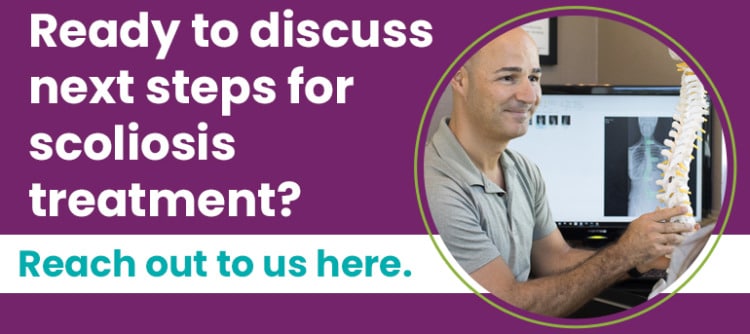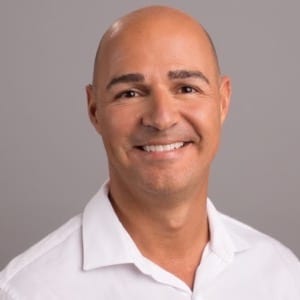Innovative Fiber Techniques in Scoliosis Surgery Explained
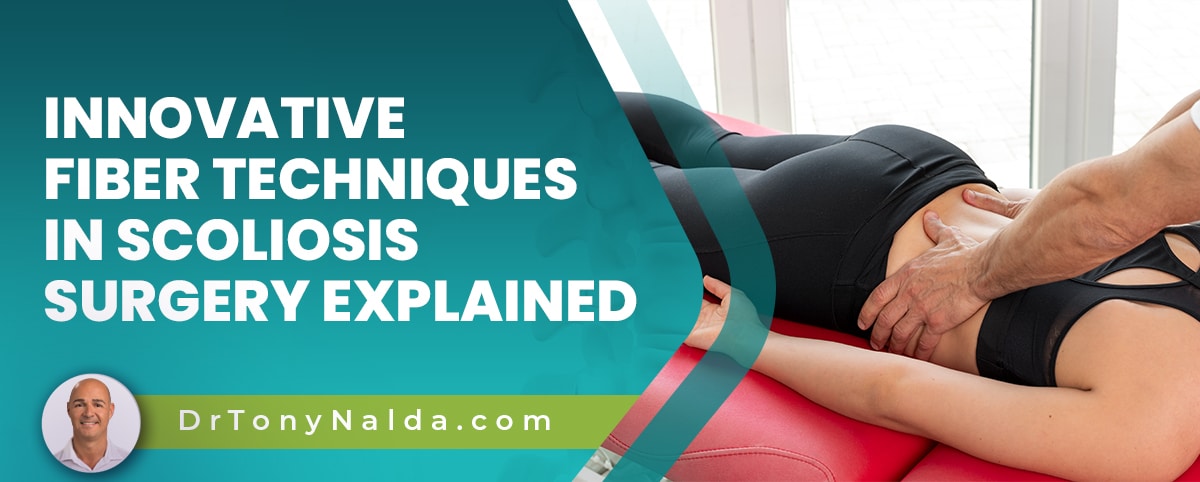
Spinal fusion surgery is a traditional scoliosis treatment response, and while surgeries always come with risks, spinal fusion can be particularly risky because of the complexity of the spine and its role within the central nervous system. Scoliosis surgery that uses fibers is considered less invasive than traditional spinal fusion that uses metal rods to secure the spine's position.
Scoliosis surgery is a type of spinal fusion that fuses the curve's most-tilted vertebrate to prevent progression. Vertebral body tethering uses fibers and is considered a minimally invasive scoliosis surgery because it uses fibers attached to the spine to adjust tension, versus traditional metal rods that can't be adjusted.
There are different types of spinal fusion surgeries, and vertebral body tethering has provides another option.
Table of Contents
What is Spinal Fusion Surgery?
Scoliosis causes the spine to develop an unnatural sideways-bending spinal curve that also rotates, and as a progressive condition, the nature of scoliosis is to become more severe over time.
Although we don't always know what causes scoliosis to develop initially, we know it's growth that triggers progression, so childhood scoliosis always needs to be taken seriously because of the potential progression they can face during growth spurts.
There are two main treatment approaches to addressing scoliosis: surgical intervention or conservative treatment.
Surgical treatment is more reactive than proactive as it doesn't work towards preventing progression and is more about responding with surgery once a significant amount has occurred; spinal fusion is often recommended in severe cases with a 45+ degree curve.
Spinal fusion surgery has the goal of stopping progression, and does so by fusing the curve's most-tilted vertebrae at its apex into one solid bone, and this often involves the removal of intervertebral discs that sit between adjacent vertebrae to be fused.
And metal rods are commonly attached to the spine with pedicle screws to hold the spine in place; hardware attached is permanent.
With traditional spinal fusion, the spine is accessed through incisions made with a scalpel; this can involve posterior spinal fusion or anterior scoliosis correction, and this can involve cutting through muscle and tissue to access the spine.
Part of the recovery process involves the muscles healing, so the more muscle fibers that have to be cut to access the spine, the longer they will take to heal.
Now traditional spinal fusion has been a dominant treatment choice for many years, but the procedure has also been modified to make it less invasive and to account for a child's growth.
What is Scoliosis Surgery Using Fibers?
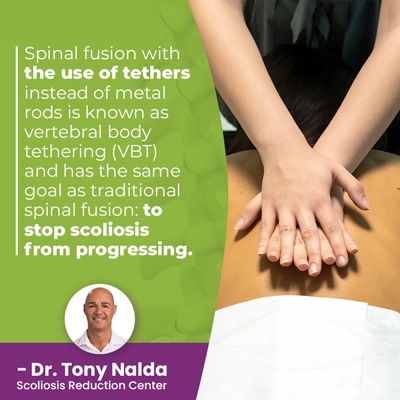 Spinal fusion with the use of tethers instead of metal rods is known as vertebral body tethering (VBT) and has the same goal as traditional spinal fusion: to stop scoliosis from progressing.
Spinal fusion with the use of tethers instead of metal rods is known as vertebral body tethering (VBT) and has the same goal as traditional spinal fusion: to stop scoliosis from progressing.
Fusing the curve's most-tilted vertebrae into one solid bone means movement in the area is eliminated, so they can't become more unnaturally tilted over time.
The process of vertebral body tethering is considered a less invasive procedure.
Instead of using rods attached to the spine with pedicle screws, VBT uses flexible tethers that are attached via screws to the affected vertebrae.
Vertebral body tethering is a type of anterior scoliosis correction because it involves making small incisions down one side of the patient's body.
The incisions are called portals, and instead of cutting through muscle as in traditional spinal fusion, muscle tissue is gently pulled apart to provide access to the spine, so recovery can be easier due to muscle sparing.
A camera and scope are passed through the portals to guide the spine surgeon who attaches screws to the affected vertebrae, then attaches flexible fiber tethers to the screws, and tension on the tethers can be easily adjusted to correct the curve.
Benefit of Fibers Versus Metallic Implants
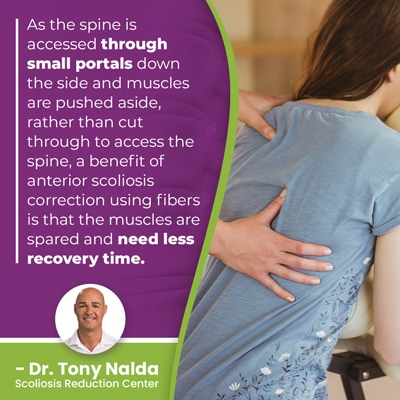 As the spine is accessed through small portals down the side and muscles are pushed aside, rather than cut through to access the spine, the benefit of anterior scoliosis correction using fibers is that the muscles are spared and need less recovery time.
As the spine is accessed through small portals down the side and muscles are pushed aside, rather than cut through to access the spine, the benefit of anterior scoliosis correction using fibers is that the muscles are spared and need less recovery time.
In addition, the main age group affected by scoliosis are adolescents, and adolescent idiopathic scoliosis is the most common type of scoliosis overall, and this age group is also the most at risk for rapid progression.
So for children who have a lot of growth to get through before reaching skeletal maturity also have a lot of potential progression to face, and dealing with progression has to be a focus of treatment.
Counteracting progression can be a challenge when patients are growing quickly, so a benefit of fibers is that their tension can be adjusted based on how the spine is responding to treatment and/or growth.
Particularly for children with intense growth spurts, vertebral body tethering can provide another surgical treatment option.
One of the biggest complaints of patients who have undergone traditional spinal fusion is the loss in spinal flexibility and range of motion they can be left with; a spine that's fused and held in place by metal rods is one that's rigid and immovable, and this is contrary to the spine's movement-based design.
A spine that's excessively rigid can also be painful, is weaker and more vulnerable to injury, and can lead to activity restrictions that can disrupt quality of life.
But what about those who don't want to face surgical risks and want a less invasive procedure?
The Benefits of Treating Scoliosis with Conservative Treatment
The benefits of treating scoliosis with conservative treatment are many; they can include preserving as much of the spine's natural strength and function as possible, reducing curve size on a structural level, improving the spine's surrounding muscle balance and strength, improving posture, and restoring the body's overall symmetry.
Spinal surgery will always come with serious potential risks, side effects, and complications, and if the procedure fails for any reason, the only recourse is revision surgery with increasing risks each time.
Conservative treatment, however, doesn't carry serious risks and potential complications; it's a natural approach to correcting the scoliosis by impacting its underlying structural nature.
Another benefit of conservative treatment is that it addresses all the effects of scoliosis, whereas scoliosis surgery focuses solely on the spine.
Many patients are disappointed that their pre-scoliosis bodies haven't returned following spinal fusion, and this is because the procedure doesn't treat the whole patient, but is focusing on the spine.
Conservative treatment addresses all condition effects, including postural changes, and when it comes to adolescents, these are the effects they tend to be the most concerned with.
Conservative Treatment Options
Through chiropractic care, curve reductions are worked towards, which reduces the condition's uneven forces and takes pressure off the spine's surroundings.
Physical therapy and scoliosis exercises target posture, and part of our exercise-based approach to treatment involves empowering patients through the use of mirror image exercises to understand how to hold their spines and bodies to best counteract their curve.
Improved posture also means a body that's more symmetrical and balanced, which helps address related changes to balance, coordination, and gait.
Corrective bracing is also a key facet of childhood scoliosis treatment because a child's spine is still growing so is more malleable and responsive to the corrective power of scoliosis bracing.
So while surgical intervention can straighten a scoliotic spine, it can also negatively affect the spine's strength, flexibility, and function, and doesn't address all the symptoms of scoliosis.
In addition, many cases of scoliosis don't need surgical treatment.
Conclusion
Spinal fusion surgery using fibers is also referred to as vertebral body tethering and anterior scoliosis correction.
While traditional spinal fusion fuses the vertebrate and attaches metal rods to the spine to hold it in place, the vertebral body tethering procedure uses flexible fibers.
The benefit of using fibers instead of metallic implants is they are more flexible so don't make the spine excessively rigid, their tension can be adjusted based on how a patient is responding to treatment and/or growth, and the way the spine is accessed isn't as damaging to the spine's surrounding muscles.
Using minimally invasive techniques can help reduce the risks of surgical treatment.
Although spinal surgeons have their patients' best interests at heart, the procedure is still risky; risks associated with the spine surgery itself can include nerve damage, excessive blood loss, infection, and adverse reaction to hardware.
There are no such risks associated with conservative treatment because it is a more natural approach that works towards preserving as much of the spine's natural strength and function as possible, and the integration of chiropractic care, physical therapy, corrective exercises, bracing, and rehabilitation can impact conditions on every level, restoring the spine and body's alignment.
There are never treatment guarantees, but when it comes to the power of conservative treatment, the sooner treatment is started the better, and the Scoliosis Reduction Center's® results speak for themselves.
Dr. Tony Nalda
DOCTOR OF CHIROPRACTIC
After receiving an undergraduate degree in psychology and his Doctorate of Chiropractic from Life University, Dr. Nalda settled in Celebration, Florida and proceeded to build one of Central Florida’s most successful chiropractic clinics.
His experience with patients suffering from scoliosis, and the confusion and frustration they faced, led him to seek a specialty in scoliosis care. In 2006 he completed his Intensive Care Certification from CLEAR Institute, a leading scoliosis educational and certification center.
About Dr. Tony Nalda
 Ready to explore scoliosis treatment? Contact Us Now
Ready to explore scoliosis treatment? Contact Us Now